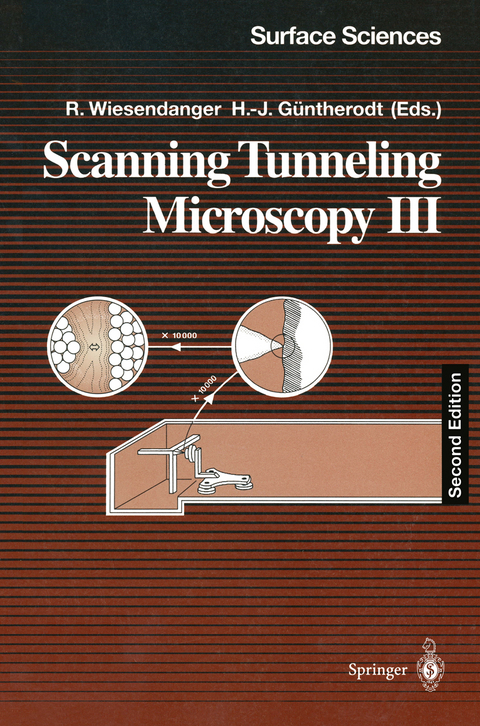
Scanning Tunneling Microscopy III
Springer Berlin (Verlag)
978-3-540-60824-0 (ISBN)
Dies ist der dritte von drei Bänden über Rastertunnelmikroskopie und verwandte Rastersensor-Methoden, die dieses Thema insgesamt umfassend behandeln. Diese drei Bände sprechen die gleiche Lesergruppe an, die nicht nur unter den Oberflächen-Physikern zu finden ist, sondern auch in der Physik allgemein, Chemie, Biologie und Materialwissenschaften.
Scanning Tunneling Microscopy III provides a unique introduction to the theoretical foundations of scanning tunneling microscopy and related scanning probe methods. The different theoretical concepts developed in the past are outlined, and the implications of the theoretical results for the interpretation of experimental data are discussed in detail. Therefore, this book serves as a most useful guide for experimentalists as well as for theoreticians working in the field of local probe methods.
In this second edition the text has been updated and new methods are discussed.
1. Introduction.- 1.1 Theoretical Concepts for Scanning Tunneling Microscopy.- 1.2 Theoretical Concepts for Force Microscopy.- References.- 2. STM Imaging of Single-Atom Adsorbates on Metals.- 2.1 Tunneling Hamiltonian Approach.- 2.2 Adsorbates on Metal Surfaces.- 2.3 Close Approach of the Tip: The Strong-Coupling Regime.- References.- 3. The Scattering Theoretical Approach to the Scanning Tunneling Microscope.- 3.1 The Theoretical Formalism.- 3.2 Tunneling Through Thick Organic Layers.- 3.3 Scanning Tunneling Microscopy at Metal Surface.- 3.4 Summary and Conclusions.- References.- 4. Spectroscopic Information in Scanning Tunneling Microscopy.- 4.1 Green's Function Method.- 4.2 Derivation of the Transfer Hamiltonian Approach.- 4.3 One-Dimensional Models.- 4.4 Three-Dimensional Models.- 4.5 Conclusion.- References.- 5. The Role of Tip Atomic and Electronic Structure in Scanning Tunneling Microscopy and Spectroscopy.- 5.1 Background.- 5.2 Formalism of Theoretical Simulation of STM/STS.- 5.3 Simulation of STM/STS of the Graphite Surface.- 5.4 STM/STS of Si(100) Reconstructed Surfaces.- 5.5 The Negative-Differential Resistance Observed on the Si(111)$$ sqrt {3} $$ × $$ sqrt {3} $$-B Surface.- 5.6 The STM Image of the Si(111)$$ sqrt {3} $$ × $$ sqrt {3} $$-Ag Surface and the Effect of the Tip.- 5.7 Light Emission from a Scanning Tunneling Microscope.- 5.8 Summary and Future Problems.- Note Added in Proof.- References.- 6. Bohm Trajectories and the Tunneling Time Problem.- 6.1 Background.- 6.2 A Brief Discussion of Previous Approaches.- 6.4 Application to Simple Systems.- 6.5 Discussion.- References.- Additional References with Titles.- 7. Unified Perturbation Theory for STM and SFM.- 7.1 Background.- 7.2 The Modified Bardeen Approach.- 7.3 ExplicitExpressions for Tunneling Matrix Elements.- 7.4 Theoretical STM Images.- 7.5 Effect of Atomic Forces in STM Imaging.- 7.6 In-Situ Characterization of Tip Electronic Structure.- 7.7 Summary.- 7.8 Appendix: Modified Bardeen Integral for the Hydrogen Molecular Ion.- References.- 8. Theory of Tip-Sample Interactions.- 8.1 Tip-Sample Interaction.- 8.2 Long-Range (Van der Waals) Forces.- 8.3 Interaction Energy: Adhesion.- 8.4 Short-Range Forces.- 8.5 Deformations.- 8.6 Atom Transfer.- 8.7 Tip-Induced Modifications of Electronic Structure.- 8.8 Calculation of Current at Small Separation.- 8.9 Constriction Effect.- 8.10 Transition from Tunneling to Ballistic Transport.- 8.11 Tip Force and Conductivity.- 8.12 Summary.- References.- 9. Consequences of Tip-Sample Interactions.- 9.1 Methodology.- 9.2 Case Studies.- References.- 10. Theory of Contact Force Microscopy on Elastic Media.- 10.1 Description of a Scanning Force Microscope.- 10.2 Elastic Properties of Surfaces.- 10.3 Interaction Between SFM and Elastic Media.- 10.4 Conclusions and Outlook.- References.- 11. Theory of Atomic-Scale Friction.- 11.1 Microscopic Origins of Friction.- 11.2 Ideal Friction Machines.- 11.3 Predictive Calculations of the Friction Force.- 11.4 Limits of Non-destructive Tip-Substrate Interactions in Scanning Force Microscopy.- References.- 12. Theory of Non-contact Force Microscopy.- 12.1 Methodical Outline.- 12.2 Van der Waals Forces.- 12.3 Ionic Forces.- 12.4 Squeezing of Individual Molecules: Solvation Forces.- 12.5 Capillary Forces.- 12.6 Conclusions.- References.- 13. Recent Developments.- 13.1 STM Imaging of Single-Atom Adsorbates on Metals.- 13.2 The Scattering Theoretical Approach to Scanning Tunneling Microscopy and Scanning Tunneling Spectroscopy.- 13.3 Theory of Atom TransferBetween the Tip and the Surface.- 13.4 Böhm Trajectories and Tunneling-Time Problem.- 13.5 Non-Contact Force Microscopy.- References.- of Scanning Tunneling Microscopy I (Springer Series in Surface Sciences, Vol. 20).- of Scanning Tunneling Microscopy II (Springer Series in Surface Sciences, Vol. 28).
| Erscheint lt. Verlag | 29.8.1996 |
|---|---|
| Reihe/Serie | Springer Series in Surface Sciences |
| Zusatzinfo | XV, 402 p. 26 illus., 3 illus. in color. |
| Verlagsort | Berlin |
| Sprache | englisch |
| Maße | 155 x 235 mm |
| Gewicht | 640 g |
| Themenwelt | Naturwissenschaften ► Chemie ► Analytische Chemie |
| Naturwissenschaften ► Physik / Astronomie ► Atom- / Kern- / Molekularphysik | |
| Naturwissenschaften ► Physik / Astronomie ► Festkörperphysik | |
| Schlagworte | electronic structure • HC/Informatik, EDV/Informatik • HC/Physik, Astronomie/Atomphysik, Kernphysik • Helium-Atom-Streuung • machine • Mikroskopie • Nanotechnologie • nanotechnology • Oberflächenbehandlung • Oberflächenphysik • Physics • Rasterelektronenmikroskopie • Rastersensormikroskopie • Rastertunnelmikroskopie • Scanning Probe Microscopy • Scanning Tunneling Microscopy • scattering • Sensor • Simulation • spectroscopy • STM • Surface • Surface Physics • Surfaces • Surface Science • Technologie • Transport • Tunneling theory • Tunneltheorie |
| ISBN-10 | 3-540-60824-9 / 3540608249 |
| ISBN-13 | 978-3-540-60824-0 / 9783540608240 |
| Zustand | Neuware |
| Haben Sie eine Frage zum Produkt? |
aus dem Bereich


